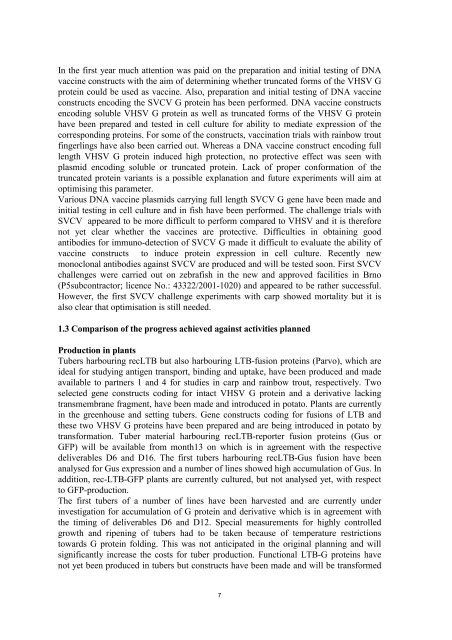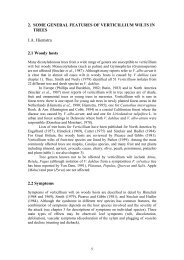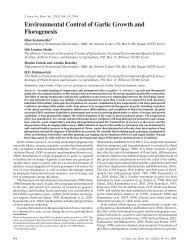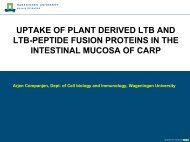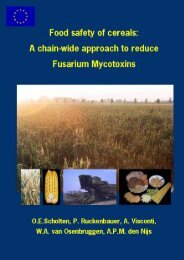CONFIDENTIAL REPORT - Plant Research International
CONFIDENTIAL REPORT - Plant Research International
CONFIDENTIAL REPORT - Plant Research International
- No tags were found...
Create successful ePaper yourself
Turn your PDF publications into a flip-book with our unique Google optimized e-Paper software.
In the first year much attention was paid on the preparation and initial testing of DNAvaccine constructs with the aim of determining whether truncated forms of the VHSV Gprotein could be used as vaccine. Also, preparation and initial testing of DNA vaccineconstructs encoding the SVCV G protein has been performed. DNA vaccine constructsencoding soluble VHSV G protein as well as truncated forms of the VHSV G proteinhave been prepared and tested in cell culture for ability to mediate expression of thecorresponding proteins. For some of the constructs, vaccination trials with rainbow troutfingerlings have also been carried out. Whereas a DNA vaccine construct encoding fulllength VHSV G protein induced high protection, no protective effect was seen withplasmid encoding soluble or truncated protein. Lack of proper conformation of thetruncated protein variants is a possible explanation and future experiments will aim atoptimising this parameter.Various DNA vaccine plasmids carrying full length SVCV G gene have been made andinitial testing in cell culture and in fish have been performed. The challenge trials withSVCV appeared to be more difficult to perform compared to VHSV and it is thereforenot yet clear whether the vaccines are protective. Difficulties in obtaining goodantibodies for immuno-detection of SVCV G made it difficult to evaluate the ability ofvaccine constructs to induce protein expression in cell culture. Recently newmonoclonal antibodies against SVCV are produced and will be tested soon. First SVCVchallenges were carried out on zebrafish in the new and approved facilities in Brno(P5subcontractor; licence No.: 43322/2001-1020) and appeared to be rather successful.However, the first SVCV challenge experiments with carp showed mortality but it isalso clear that optimisation is still needed.1.3 Comparison of the progress achieved against activities plannedProduction in plantsTubers harbouring recLTB but also harbouring LTB-fusion proteins (Parvo), which areideal for studying antigen transport, binding and uptake, have been produced and madeavailable to partners 1 and 4 for studies in carp and rainbow trout, respectively. Twoselected gene constructs coding for intact VHSV G protein and a derivative lackingtransmembrane fragment, have been made and introduced in potato. <strong>Plant</strong>s are currentlyin the greenhouse and setting tubers. Gene constructs coding for fusions of LTB andthese two VHSV G proteins have been prepared and are being introduced in potato bytransformation. Tuber material harbouring recLTB-reporter fusion proteins (Gus orGFP) will be available from month13 on which is in agreement with the respectivedeliverables D6 and D16. The first tubers harbouring recLTB-Gus fusion have beenanalysed for Gus expression and a number of lines showed high accumulation of Gus. Inaddition, rec-LTB-GFP plants are currently cultured, but not analysed yet, with respectto GFP-production.The first tubers of a number of lines have been harvested and are currently underinvestigation for accumulation of G protein and derivative which is in agreement withthe timing of deliverables D6 and D12. Special measurements for highly controlledgrowth and ripening of tubers had to be taken because of temperature restrictionstowards G protein folding. This was not anticipated in the original planning and willsignificantly increase the costs for tuber production. Functional LTB-G proteins havenot yet been produced in tubers but constructs have been made and will be transformed7


